Jan Svoboda. Magnetic Techniques for the Treatment of Materials
Подождите немного. Документ загружается.

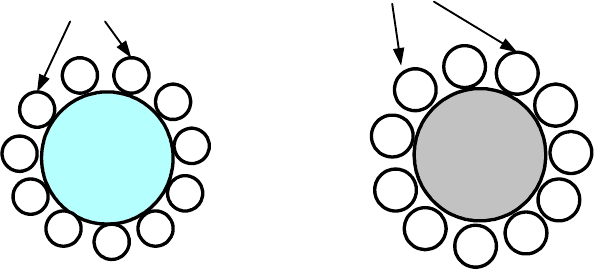
520 CHAPTER 6. INDUSTRIAL APPLICATIONS
Magnetic
carrier
Target
species
Target (non-magnetic)
species
Magnetic tags
(i) Magnetic carrier
(ii) Magnetic tagging
Figure 6.44: Schematic representation of magnetic carrier and magnetic tagging
techniques.
by a magnetic separator operating at 0.2 T. It can thus be seen that a volume
fraction of the magnetic carrier material in the range 0.05% to 1% is enough to
make the target material su!ciently magnetic for easy separation.
There are two basic mechanisms for using a magnetic particle so that it
renders a non-magnetic particle magnetic, namely as a magnetic carrier or as a
magnetic tag. These mechanisms are schematically shown in Fig. 6.44.
Magnetic carriers are usually 10 to 1000 times larger than the target species
[M40]. By varying the surface characteristics, selective recovery of non-magnetic
colloidal and macromolecular species can be achieved by attaching the desired
species onto the surface, or entrapped within, magnetic carrier particles, as is
illustrated in Fig. 6.44. Fine magnetite and polymer-based beads coated with
magnetite are frequently used as magnetic carriers, depending on application.
Magnetic tags, on the other hand, are usually smaller than the target non-
magnetic particles. These particles, often very fine magnetite or ions (e.g. Y
3+
),
coat non-magnetic species in order to allow them to be manipulated by an
external magnetic field. In view of their small size the mean magnetization of
the cluster is low and large magnetic fields are often required for their recovery.
6.4.2 E"uent processing and metal ion removal
Magnetic seeding
The earliest examples of the use of magnetic carriers are in e"uent treatment
using ground magnetite to remove organic impurities from industrial waste wa-
ters. In this process a coagulant (e.g. alum) was added to the feed stream,

6.4. MAGNETIC CARRIER TECHNIQUES 521
Pressurized air
Water tank
Non-magnetic
sludge
Magnetic sludge
Seed recovery
HGMS
HGMS
Floc breaking
Feed
Seeds and
flocculant
Clean water
Figure 6.45: Magnetic filtration process with a magnetic seeding technique
(adapted from [K32]).
at concentrations ranging from 10 to 200 mg/c, followed by the addition of the
magnetite seed in a concentration from 50 to 5000 mg/c. The magnetic particles
coagulated with the non-magnetic impurities, thereby allowing the flocs to be
recovered by a magnetic separator. The flowsheet of the process is shown in
Fig. 6.45.
De Latour and Kolm [D19, D20] and Bitton and Mitchell [M41, B42] con-
ducted some pioneering work on magnetic filtration of river water using the
magnetite seeding technique. The results demonstrated the e!ciency of this
technique for the removal of bacteria, viruses, algae and non-magnetic solids
and for improving turbidity and colour of the water. The removal e!ciency was
around 95% and was strongly dependent on the pH.
The development of an industrial-scale process was carried out in the late
nineteen seventies at Sala Magnetics. The applicability of magnetic seeding
filtration to sewage and combined storm and sewage overflow was studied on
pilot-plant scale and a comparison between HGMS and other sewage treatment
processes is shown in Table 6.24. [A40, A41].
Selective removal of oil, phosphorus and heavy metals from waste water
by a combination of magnetic seeding, chemical coagulation and high-gradient
magnetic separation has been demonstrated in several reports [B43, O9,T12].
In order to overcome limitations of a cyclic operation of high-gradient mag-
netic filters and high energy consumption, Isogami et al. [I5] developed a contin-
uous superconducting filter for the treatment of sewage water. By the applica-
tion of the magnetite seeding technique, the level of biological oxygen demand
was reduced by 90%, chemical oxygen demand by 79% and concentration of
suspended solids by 97%. Figure 6.46 shows the pilot plant at Hitachi, Ltd.
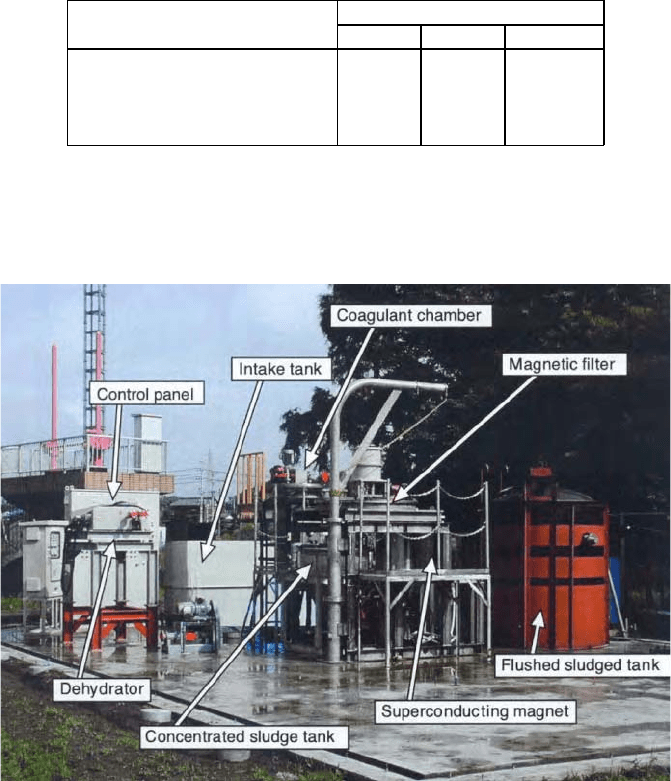
522 CHAPTER 6. INDUSTRIAL APPLICATIONS
Table 6.24: Comparison between HGMS and other sewage treatment processes
[O8].
Process Removal [%]
Solids COD Bacteria
HGMS 88 - 95 60 - 75 99 - 99.9
Chemical clarification 60 - -
Activated sludge treatment 55 - 95 70 - 80 90 - 98
Physical chemical treatment 99 80 99
Figure 6.46: A pilot plant for magnetic filtration of waste water, using a con-
tinuously operating superconducting magnet (courtesy of Hitachi,
Ltd.).

6.4. MAGNETIC CARRIER TECHNIQUES 523
pH
adjustment
Water +
magnetite
Slurry +
coagulant
Magnetic
flocculation
Magnetite +
NaOH
Solid/liquid
separation
Wash
magnetite
Solid/liquid
separation
Feed
Demag
coil
Coagulant
Magnetite
Liquid effluent
Liquid effluent
Clean water
Loaded
magnetite
Figure 6.47: Flowsheet diagram for water treatment with reusable magnetite
particles (adapted from [A42]).
(Japan).
Magnetic coating
This process relies on the selective adhesion of fine magnetic particles to the
surfaces of target materials, as is shown in Fig. 6.43(ii). Fine particles, usually
smaller than 2 m, are required to form resilient coatings on the minerals [P20,
P21]. The selective removal of calcite and dolomite, from mixtures of apatite,
barite and scheelite, by selective magnetic coating, or tagging, has been demon-
strated at laboratory and pilot plant scale [P20]. Other mixtures that were
separated are quartz/fluorite and metallic lead/copper.
Coating of particles with magnetic tags has not yet been exploited to any
significant extent on industrial scale. However, tags can be potentially used
in recovering suspended particulates from a wide spectrum of materials and
magnetic coating can provide a basis for selective separation of minerals, e"uent
particles and organic wastes [M40].
Sirofloc
WP
process
The Sirofloc
WP
process developed at CSIRO (Australia) [K33] employs the
magnetite seeding technique. It is established that a surface of magnetite parti-
cles activated in acid environment is positively charged, which enables negatively
charged particles of the impurities contained in the water to be captured on the
surface of the magnetite particles. On the other hand, in an alkaline environ-
ment, the surfaces of the magnetite particles are charged negatively and thus
repulsion of charged particles from the magnetite surface takes place. Magnetite
thus acts as an impurity adsorbent in acid environment and as a desorbent in
alkaline medium.

524 CHAPTER 6. INDUSTRIAL APPLICATIONS
Table 6.25: River water treatment by chemically precipitated magnetite and
HGMS [H33].
Parameter Untreated water Treated water
Colour [mg/c Pt] 40 8
Turbidity [ZF] 11.5 1.5
COD [mg/c] 11.5 1.5
Fe total [mg/c] 0.23 0.01
No. of psychrophylic bacteria/mc 1000 130
No. of coliform bacteria/mc 13 0.02
Kolarik’s results [K33] were tested on pilot-plant scale, the process flowsheet
of which is shown in Fig. 6.47. It was demonstrated in several plants that have
been in operation in Australia and UK that the process can produce water which
complies with the EC Drinking Water Directive [B40].
The magnetite particles used in the Sirofloc process are rather coarse (5 to
10 m), which results in their low specific surface area and in the need to use
a high concentration of magnetite (e.g. 10 to 12 g/c). Moreover, preparation
of magnetite in this size range is rather costly and complex. In order to over-
come this drawback, Hencl and Mucha [H33] proposed to employ chemically
precipitated magnetite [O9] prepared from waste material, such as acid pickling
steel liquor or waste ferrous sulphate arising from production of titanium white.
Magnetite prepared in this manner, with 90% of particles smaller than 1 m
and 54.3% smaller than 0.4 m, was used to purify the Vltava River (Czech
Republic) water. The impurity-coated magnetite was concentrated by HGMS
operating at 0.5 T at a flow velocity of 0.1 m/s. As can be seen from Table 6.25,
colour was improved by 79%, while turbidity and COD were reduced by 85%
and 76.4%, respectively. The concentration of coliform bacteria was reduced by
99.9%.
6.4.3 Biomagnetic extraction of heavy metals
The phenomenon of bioaccumulation of metal ions from solution by a wide va-
riety of micro-organisms has been well established for some time. A number
of micro-organisms can precipitate heavy metals onto their surfaces as a conse-
quence of their metabolism and growth. This, therefore, gives them the ability
to accumulate such metals in large quantities from external surroundings.
Microbial accumulation is achieved by growing a variety of micro-organisms
in solutions containing the ions of the metal to be extracted and some added
nutrients. As the microorganisms grow, they accumulate the metallic species
onto their surfaces with a corresponding decrease in the concentration of the
metal ion in solution. If the ions are paramagnetic, the resultant coating on
a microorganism makes it magnetic and magnetic separation can be used to
extract the biomass from the solution. A block diagram of the process is shown
in Fig. 6.48.
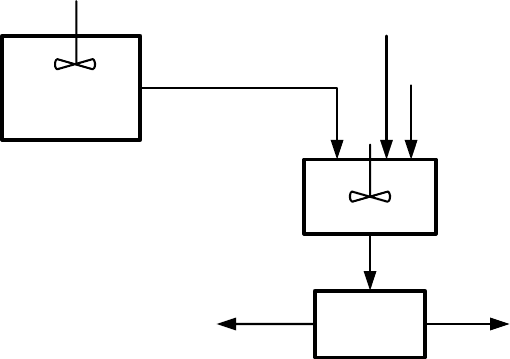
6.5. MAGNETIC CARRIERS AND SEPARATION IN BIOSCIENCES 525
Chemostat
HGMS
Organism growth
on specific medium
Medium
Effluent
(metals ions)
Decontaminated
effluent
Metal-coated
organisms
Figure 6.48: Block diagram of growth and separation of microorganisms loaded
with heavy metals (adapted from [B44]).
Watson et al. [W34, B44] investigated a large number of magnetic ion species
and of microorganisms and their ability to ingest or precipitate ion species onto
their surfaces. The work was directed towards a study of e"uents from nuclear
and other industries. In most cases, starting concentrations of heavy metals
of the order of 10 ppm were reduced to the 1 ppb level. Successful tests were
carried out on solutions containing U, Cu, Pt, Pd, Rh, Rd, Fe, Ni and other
metals.
6.5 Magnetic carriers and magnetic separation
in biosciences
6.5.1 Principles of biomagnetic separation techniques
With the exception of a few naturally occurring paramagnetic or ferrimagnetic
molecules or cells, such as ferritin, deoxygenated erythrocytes and magneto-
tactic bacteria, biological material is diamagnetic and has to be magnetically
labelled or immobilized on magnetic particles. The magnetic labelling or im-
mobilization can be performed using magnetic carriers, magnetic nanoparticles,
magnetoliposomes and molecular magnetic labels (such as erbium ions) [S88].
Magnetic carriers, in the form of either magnetite or magnetic polymer par-
ticles, or beads, are being increasingly used to separate, analyze and diagnose
cells or biomolecules such as antibodies, DNA molecules, proteins, hormones or
antigens. Drug and reagent delivery are another area where magnetic carriers
or tags are finding their application.
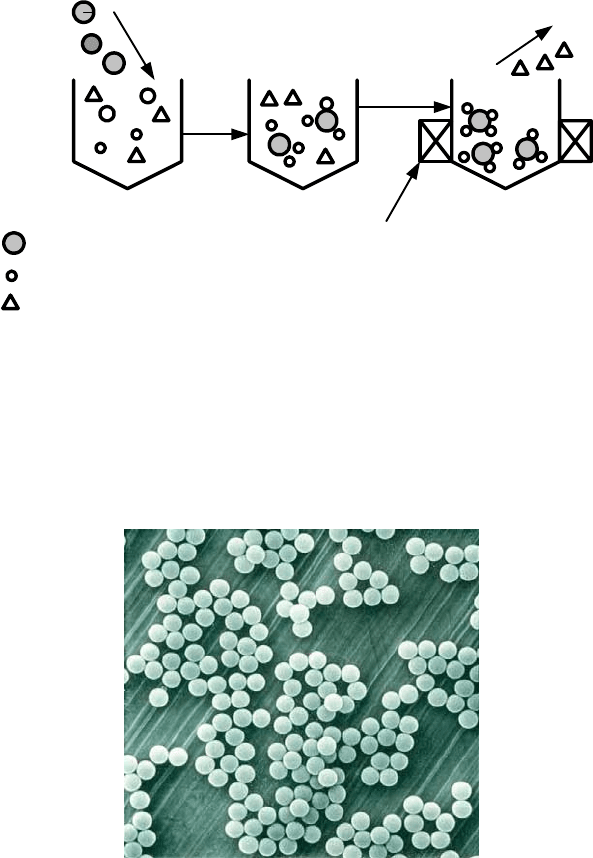
526 CHAPTER 6. INDUSTRIAL APPLICATIONS
Magnetic beads in
Capture of target cells
1 on beads
Magnetic separation of
target cells 1
Removal of cells 2
Magnetic bead
Cell 1
Cell 2
Magnet
Figure 6.49: Schematic diagram of magnetic separation of cells using magnetic
beads.
Figure 6.50: A scanning electron microscope image of 2.8 mDynabeads
R
°
su-
perparamagnetic monosized polymer magnetic carriers (courtesy of
Dynal Biotech ASA).

6.5. MAGNETIC CARRIERS AND SEPARATION IN BIOSCIENCES 527
Table 6.26: Physical characteristics of magnetic carriers Dynabeads.
Head Dynabeads
R
°
M-450 M-280 MyOne
Diameter 4.5 m 2.8 m 1.05 m
Density 1600 kg/m
3
1400 kg/m
3
1800 kg/m
3
Fe content 20% 12% 26%
The magnetic beads are usually spherically shaped particles of diameter
ranging from 1 to 20 m, and consist of a polymer matrix, often polystyrene,
polyderivatives and polyvinylalcohol, in which a magnetic colloid, such as mag-
netite, is encapsulated. Specific a!nity ligands are chemically coupled, often
selectively, to the polymer matrix to separate biomolecules or cells. These lig-
ands display complementary structures to specific sites of biomolecules or cell
receptors so that these target substances specifically bind to the magnetic parti-
cles. These target structures can then be separated from the substance mixture
in a magnetic field. Many magnetic carriers are biocompatible and some of them
are biodegradable. The basic principle of cell separation is shown schematically
in Fig. 6.49. A scanning electron microscope image of 2.8 m magnetic carriers
Dynabeads
R
°
is shown in Fig. 6.50, while Table 6.26 lists physical properties of
Dynabeads
R
°
.
In addition to magnetic carriers in the micrometer size range, magnetic
nanoparticles in the form of ferrofluids are often used for the labelling of tar-
get structures (usually cells) and as biodegradable or biocompatible carriers
for biomedical applications. In contrast to micrometer-sized magnetic carri-
ers, high-gradient magnetic separators are required to manipulate systems of
magnetic nanoparticles.
In addition to its current progressive role in biosciences, novel developments
in the biocompatible magnetic carrier technique are expected to have an en-
abling eect on capabilities in biological warfare defence, personnel monitoring
and diagnostic and therapeutic treatments for military personnel. For instance,
the Department of Defence (USA) believes that magnetic carriers are suited to
provide mechanisms for monitoring and controlling biological activity [B45].
Magnetic separation, such as isolation and/or removal of specific cells, iso-
lation of nucleic acids, proteins and heavy metals, is a common approach to
exploit magnetic principles in biosciences. Biomagnetic techniques can be used
in a variety of other applications. Magnetic support can be applied to immobi-
lization of biologically active compounds and cells when magnetic carriers enable
simple manipulation with immobilized structures.
Magnetic separation can also be used for modification of standard immunoas-
say analytical methods to determine concentrations of analytes in medical di-
agnostics. Ferrofluids have been studied in biomedical and clinical applications,
often in connection with manipulation of drugs, viruses and tumours.
The separation of erythrocytes (red blood cells) from the remainder of the
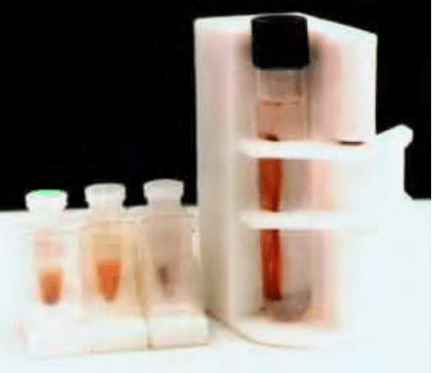
528 CHAPTER 6. INDUSTRIAL APPLICATIONS
Figure 6.51: A batch magnetic separator for biomedical applications (courtesy
of Dynal Biotech ASA).
blood components using high-gradient magnetic separation has received con-
siderable attention during the last two decades. The same technique has been
successfully applied to the concentration of malarial parasites and bone marrow
cells.
Magnetic separation has several advantages in comparison with standard
separation procedures. Separation can often be performed directly in raw sam-
ples containing suspended solid material such as body fluids, food and clinical
samples and waste water. As a result of their magnetic properties, target struc-
tures captured to specific surface-modified magnetic particles or magnetically
modified a!nity materials can be relatively easily and selectively removed from
the sample in an external magnetic field.
A review of the current status of the application of magnetic methods in
biosciences can be found, for instance, in an article by Šafa
ˇ
ríková and Šafa
ˇ
rík
[S88].
6.5.2 Magnetic separators in biosciences
In recent years numerous magnetic separators have become available for appli-
cations in biosciences, ranging from small laboratory units based on permanent
magnets, to automated cell sorters that are able to separate up to 10 million
magnetically labelled cells per second. There are two basic types of laboratory
magnetic separators for biomedical applications, namely batch and flow-through
units [S88].
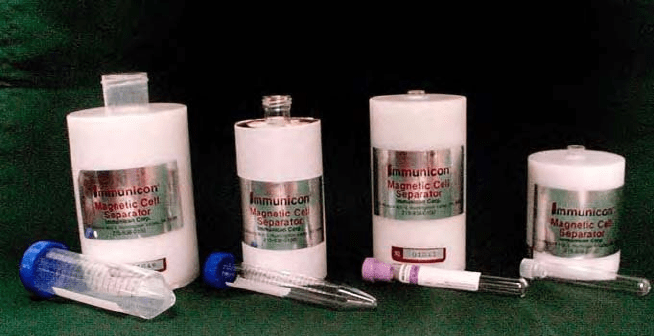
6.5. MAGNETIC CARRIERS AND SEPARATION IN BIOSCIENCES 529
Figure 6.52: Quadrupole and hexapole batch magnetic separators for biomedical
applications (courtesy of Immunicon, Inc.).
Batch magnetic separators
In most cases the isolation of magnetically labelled structures is performed in a
batch mode. Test tube magnetic separators, an example of which is shown in
Fig. 6.51, equipped with rare-earth permanent magnets, are used to separate
magnetic microparticles from volumes ranging from 5c to 50 mc. Magnetic
nanoparticles require a higher magnetic force and can thus be separated in
quadrupole or hexapole magnetic fields. Such QMGS and HMGS separators
are shown in Fig. 6.52.
Flow-through magnetic separators
Flow-through separators are cyclic units consisting of a column packed with
magnetizable stainless steel wool, placed between the poles of a permanent mag-
net or electromagnet. Magnetically labelled structures are passed through the
column and are captured in the steel wool matrix. After the removal of the
column from the magnetic field, the captured structures are removed from the
matrix. High-gradient magnetic separators are used when working with sub-
colloidal particles, particularly when separating magnetically labelled cells. De-
vices that can separate 10
10
to 10
11
cells in one cycle have become commercially
available [S88].
Improved selectivity of separation of biological objects can be obtained when
multipole d.c. magnetic fields or a.c. magnetic field are used. A flow-through
quadrupole magnetic separator [Z2] generating a field gradient of 164 T/m and
a hybrid a.c. magnetic device [G23] have been applied in various a!nity-based
separations.
